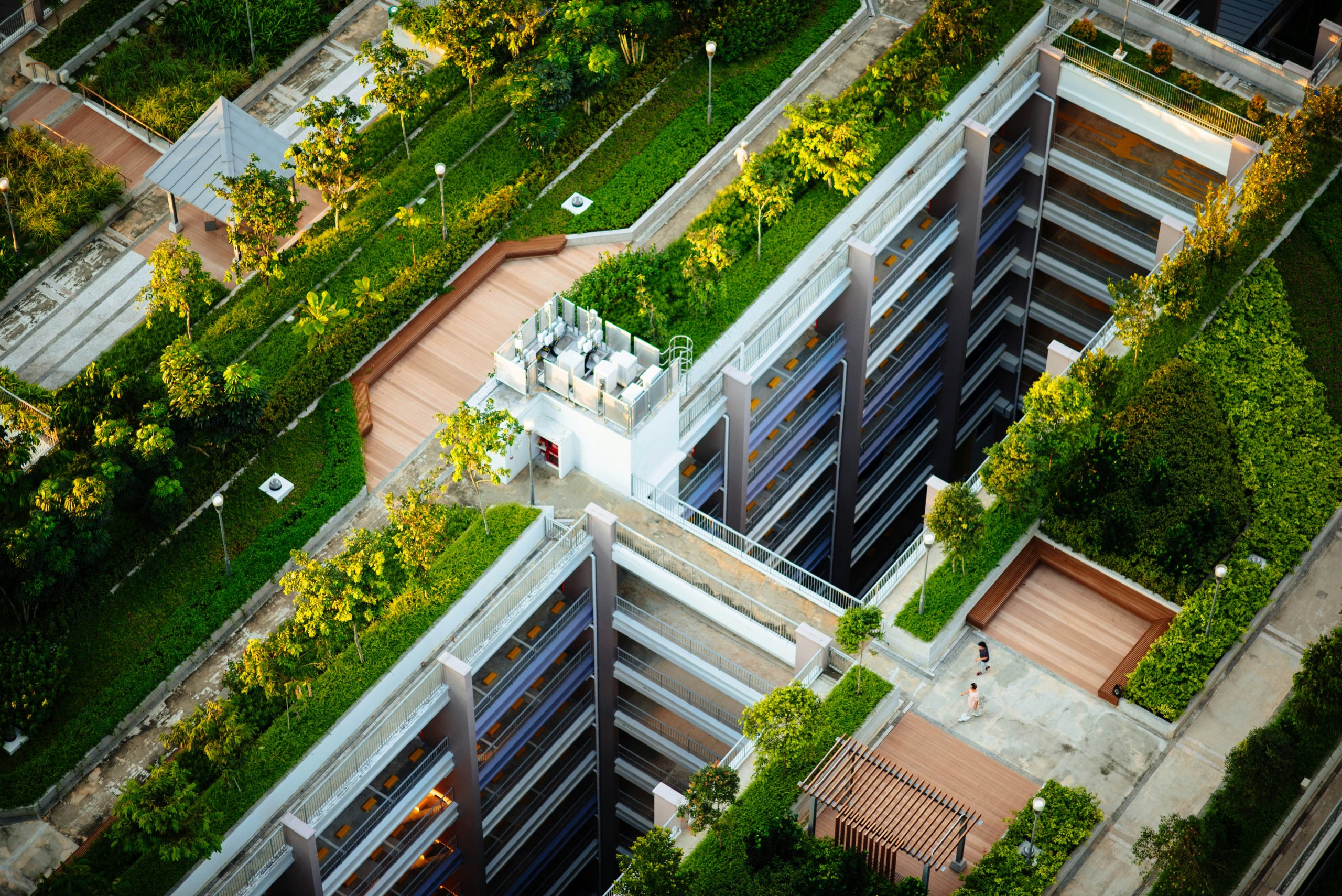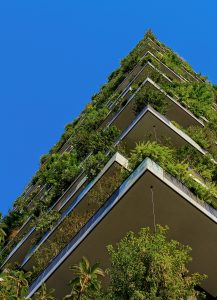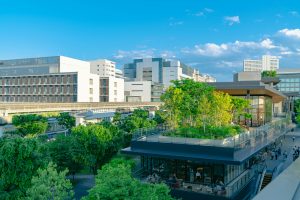In our exploration of how sustainable architecture reduces our carbon footprint, we’ll delve into the innovative strategies and technologies that make eco-friendly building design both practical and impactful. This article will guide us through the core principles of sustainable architecture, spotlighting the ways it minimizes environmental impact—ranging from energy-efficient materials to smart building systems. Let’s uncover how these forward-thinking designs not only benefit our planet but also enhance our quality of life. Have you ever wondered how sustainable architecture can help us reduce our carbon footprint? We often hear about the need for greener practices and sustainable building methods, but understanding the tangible benefits and mechanisms can be quite enlightening. As we continue to face the impacts of climate change, the importance of sustainable architecture becomes ever more critical. By examining the ways in which sustainable design and construction practices contribute to reducing our carbon footprint, we can better appreciate the role this field plays in preserving our planet.

Understanding Sustainable Architecture
Sustainable architecture, also known as green architecture, is a method of design and construction that seeks to minimize the environmental impact of buildings. It emphasizes the use of renewable resources, energy efficiency, and eco-friendly materials. The goal is not only to create structures that are comfortable and functional but also to ensure that they contribute to the well-being of the environment.
Core Principles of Sustainable Architecture
To fully grasp how sustainable architecture can reduce our carbon footprint, it’s essential to understand its core principles:
- Energy Efficiency: Making use of natural light, proper insulation, and energy-efficient systems.
- Renewable Energy: Incorporating solar panels, wind turbines, and other renewable energy sources.
- Water Efficiency: Designing buildings to use water more efficiently through low-flow fixtures and rainwater harvesting.
- Sustainable Materials: Using recycled, renewable, and locally sourced materials.
- Waste Reduction: Minimizing waste during the construction process and throughout the lifespan of the building.
- Indoor Environmental Quality: Ensuring that indoor spaces have good air quality, ventilation, and natural lighting.
The Role of Technology in Sustainable Architecture
Advancements in technology play a significant role in sustainable architecture. Innovations such as smart grids, energy management systems, and sustainable building materials have made it easier to design and construct environmentally friendly buildings. As technology continues to evolve, so too does our ability to reduce our carbon footprint through sustainable practices.
Energy Efficiency in Sustainable Architecture
Energy consumption is one of the most significant contributors to a building’s carbon footprint. By focusing on energy efficiency, we can significantly reduce the amount of energy required to operate a building, thus lowering its overall carbon emissions.
Passive Design Strategies
Passive design strategies aim to take advantage of a building’s natural surroundings to maintain comfortable indoor temperatures without relying heavily on mechanical systems. Some of these strategies include:
- Orientation: Positioning buildings to maximize natural light and heat from the sun.
- Insulation: Using high-quality insulation materials to reduce the need for heating and cooling.
- Natural Ventilation: Designing buildings to facilitate airflow and reduce the need for air conditioning.
Active Design Strategies
While passive strategies are crucial, active design strategies also play an essential role in energy efficiency:
- Energy-Efficient Systems: Installing energy-efficient HVAC systems, lighting, and appliances.
- Smart Technology: Implementing smart thermostats, lighting controls, and energy management systems to optimize energy use.
- Renewable Energy Sources: Integrating solar panels, wind turbines, and geothermal systems to generate clean energy on-site.
Impact on Carbon Footprint
By incorporating both passive and active design strategies, sustainable architecture can significantly reduce the energy required to operate a building. This, in turn, leads to a substantial decrease in carbon emissions.
Energy Efficiency Comparison Table
| Traditional Building Design | Sustainable Architecture |
|---|---|
| Relies heavily on fossil fuels for heating and cooling. | Utilizes passive design strategies to reduce energy demand. |
| Low-quality insulation leading to energy loss. | High-quality insulation minimizing energy loss. |
| Standard HVAC systems with high energy consumption. | Energy-efficient HVAC systems and smart technology. |
| Limited use of renewable energy sources. | Integration of solar panels, wind turbines, and other renewable sources. |
Renewable Energy Integration
Sustainable architecture takes a proactive approach to reducing reliance on fossil fuels by integrating renewable energy sources into building design. This not only lowers a building’s carbon footprint but also promotes the use of clean energy.
Solar Energy
Solar energy is one of the most popular and widely used renewable energy sources in sustainable architecture. By installing solar panels on rooftops or other suitable areas, we can harness the sun’s energy to power buildings. Photovoltaic (PV) cells convert sunlight directly into electricity, reducing the need for grid-supplied power and cutting down on greenhouse gas emissions.
Wind Energy
In regions with sufficient wind speeds, wind turbines can be an effective way to generate clean electricity. Small-scale wind turbines can be installed near buildings to supplement their energy needs. While not suitable for all locations, wind energy can be a valuable addition to a building’s renewable energy portfolio.
Geothermal Energy
Geothermal energy leverages the stable temperatures found below the Earth’s surface to provide heating and cooling for buildings. By using geothermal heat pumps, we can transfer heat from the ground into buildings during the winter and vice versa during the summer. This method is highly efficient and significantly reduces the need for traditional heating and cooling systems.
Impact on Carbon Footprint
Integrating renewable energy sources into building design helps reduce reliance on fossil fuels, thereby cutting down on carbon emissions. The more we can generate clean energy on-site, the lower our overall carbon footprint will be.
Water Efficiency and Conservation
Water is a precious resource, and sustainable architecture aims to use it as efficiently as possible. By incorporating water-saving technologies and practices, we can reduce the strain on our water supply and minimize the energy required to treat and transport water.
Low-Flow Fixtures
Low-flow fixtures, such as faucets, showerheads, and toilets, reduce the amount of water used without compromising performance. By installing these fixtures, we can significantly decrease water consumption in buildings.
Rainwater Harvesting
Rainwater harvesting systems collect and store rainwater for non-potable uses such as irrigation, flushing toilets, and washing clothes. This reduces the demand for treated water and helps conserve our water supply.
Greywater Recycling
Greywater recycling systems treat and reuse water from sinks, showers, and washing machines for non-potable purposes. This not only conserves water but also reduces the energy required for water treatment and distribution.
Impact on Carbon Footprint
By implementing water-efficient practices and technologies, sustainable architecture reduces the energy needed for water treatment and transportation. This, in turn, leads to lower carbon emissions associated with water usage.

Sustainable Building Materials
The materials used in construction have a significant impact on a building’s carbon footprint. Sustainable architecture prioritizes the use of materials that are environmentally friendly, renewable, and locally sourced.
Recycled and Reclaimed Materials
Using recycled and reclaimed materials helps reduce the demand for new resources and minimizes waste. Examples include using reclaimed wood, recycled metal, and recycled glass in construction projects.
Renewable Materials
Renewable materials, such as bamboo and cork, can be grown and harvested sustainably. These materials have a lower environmental impact compared to traditional building materials like concrete and steel.
Locally Sourced Materials
Sourcing materials locally reduces the carbon emissions associated with transportation. Additionally, local materials are often better suited to the regional climate and environmental conditions.
Impact on Carbon Footprint
By selecting sustainable building materials, we can reduce the environmental impact of construction and lower the overall carbon footprint of a building.
Sustainable Materials Comparison Table
| Traditional Materials | Sustainable Materials |
|---|---|
| Concrete, steel, and glass with high environmental impact. | Recycled, reclaimed, renewable, and locally sourced materials. |
| Significant carbon emissions from production and transportation. | Reduced carbon emissions due to lower resource demand and transportation. |
Waste Reduction in Construction
The construction industry generates a considerable amount of waste, much of which ends up in landfills. Sustainable architecture aims to minimize waste production during construction and throughout the building’s lifespan.
Reducing Construction Waste
By adopting efficient construction practices and using prefabricated components, we can significantly reduce the amount of waste generated during the building process. Careful planning and material management can also help minimize waste.
Recycling and Reusing Materials
Recycling and reusing construction materials is another effective way to reduce waste. Instead of sending materials to landfills, we can repurpose them for other projects or recycle them into new building materials.
Design for Disassembly
Design for disassembly (DfD) is an approach that ensures buildings can be easily deconstructed at the end of their life cycle. This allows materials to be reused or recycled, reducing the overall waste produced by the building.
Impact on Carbon Footprint
By reducing waste and promoting recycling and reuse, sustainable architecture minimizes the environmental impact of construction. This results in a lower carbon footprint for each project.

Indoor Environmental Quality
Indoor environmental quality (IEQ) is a critical aspect of sustainable architecture. It focuses on creating healthy and comfortable indoor spaces for occupants while minimizing the environmental impact.
Natural Lighting
Maximizing natural lighting in buildings reduces the need for artificial lighting, saving energy and reducing carbon emissions. Large windows, skylights, and light wells can help bring in more natural light.
Indoor Air Quality
Good indoor air quality is essential for the health and well-being of occupants. Sustainable architecture incorporates ventilation systems, air purifiers, and low-VOC (volatile organic compound) materials to ensure clean and healthy indoor air.
Thermal Comfort
Thermal comfort is achieved by maintaining a comfortable temperature range within buildings. Sustainable architecture uses insulation, shading devices, and passive heating and cooling techniques to create a comfortable indoor environment.
Impact on Carbon Footprint
Improving indoor environmental quality not only enhances the well-being of occupants but also contributes to energy efficiency. By reducing the need for artificial lighting, heating, and cooling, we can lower a building’s carbon footprint.
Case Studies in Sustainable Architecture
To better understand the real-world impact of sustainable architecture, let’s explore some notable case studies that showcase the benefits of green building practices.
Case Study 1: The Bullitt Center
The Bullitt Center in Seattle, Washington, is often referred to as the “world’s greenest commercial building.” This six-story office building was designed to be energy-efficient and environmentally friendly.
Key Features
- Net-Zero Energy: The building generates all of its energy on-site using solar panels.
- Rainwater Harvesting: It collects and treats rainwater for all its water needs.
- Living Roof: The roof is covered with vegetation to provide insulation, reduce runoff, and create habitat.
Impact on Carbon Footprint
The Bullitt Center’s innovative design reduced its carbon footprint significantly, making it a model for sustainable architecture.
Case Study 2: Bosco Verticale
Bosco Verticale, or the “Vertical Forest,” is a pair of residential towers in Milan, Italy, covered in thousands of trees and shrubs. This unique design serves both aesthetic and environmental purposes.
Key Features
- Green Facade: The towers host over 20,000 plants, which help absorb CO2 and produce oxygen.
- Energy Efficiency: The plants provide natural insulation, reducing energy needs for heating and cooling.
- Biodiversity Support: The vegetation creates habitats for birds and insects.
Impact on Carbon Footprint
Bosco Verticale demonstrates how integrating greenery into building design can drastically reduce carbon emissions and enhance urban biodiversity.
Case Study 3: One Central Park
One Central Park in Sydney, Australia, is a mixed-use development that combines luxury living with sustainability. The building features innovative design elements that prioritize environmental responsibility.
Key Features
- Heliostat: A system of mirrors reflects sunlight into shaded areas, reducing the need for artificial lighting.
- Green Walls: The building’s facade is adorned with vertical gardens, improving air quality and providing natural insulation.
- Water Recycling: The complex includes a water recycling plant that treats and reuses wastewater.
Impact on Carbon Footprint
One Central Park’s sustainable design reduces its carbon footprint while offering residents a high-quality living environment.
Challenges and Future of Sustainable Architecture
While sustainable architecture offers numerous benefits, it also faces certain challenges. Understanding these challenges can help us develop better strategies for promoting green building practices.
Cost Considerations
Initial costs for sustainable building materials and technologies can be higher than traditional options. However, the long-term savings in energy and maintenance often offset these initial expenses.
Regulatory Hurdles
Building codes and regulations may not always support innovative sustainable practices. Advocating for updated regulations and incentives can help overcome these barriers.
Awareness and Education
Increasing awareness and education about the benefits of sustainable architecture is crucial for widespread adoption. This includes educating architects, builders, and the general public about green building practices.
Future Trends
As technology continues to advance, new trends in sustainable architecture are emerging. These include:
- Smart Buildings: Integrating AI and IoT to optimize energy use and improve efficiency.
- Biophilic Design: Incorporating natural elements into building design to enhance well-being and reduce environmental impact.
- Circular Economy: Designing buildings with materials that can be recycled or repurposed at the end of their life cycle.
Conclusion
Sustainable architecture holds the key to significantly reducing our carbon footprint and ensuring a healthier environment for future generations. By embracing energy efficiency, renewable energy sources, water conservation, sustainable materials, waste reduction, and indoor environmental quality, we can create buildings that are not only functional and aesthetically pleasing but also environmentally responsible.
The real-world examples of sustainable architecture and the ongoing advancements in this field demonstrate that a greener future is within our reach. As we continue to innovate and adopt sustainable practices, we can collectively work towards a more sustainable world, one building at a time. Let’s take these steps together and make a positive impact on our planet.



